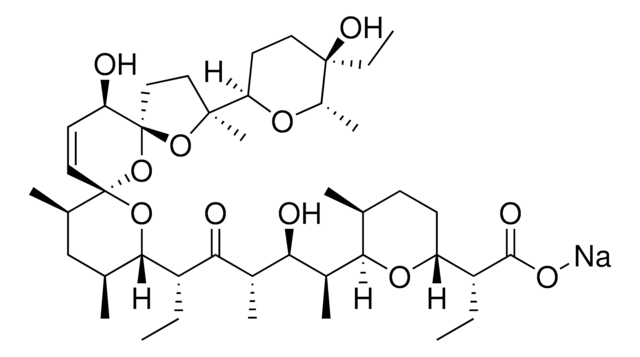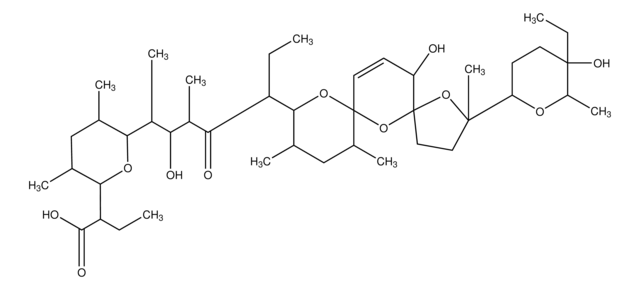M5273
Monensin sodium salt
90-95% (TLC)
Synonym(s):
Monensin A sodium salt
About This Item
Recommended Products
Assay
90-95% (TLC)
antibiotic activity spectrum
Gram-negative bacteria
Gram-positive bacteria
fungi
parasites
viruses
Mode of action
cell membrane | interferes
storage temp.
2-8°C
SMILES string
[H][C@]1([C@@]2(CC)O[C@]([C@@]3(C)OC4(C[C@H](O)[C@@H](C)[C@@]([H])([C@@H](C)[C@@H](OC)[C@@H](C([O-])=O)C)O4)CC3)([H])CC2)[C@@H](C)C[C@]([H])([C@@]5([H])O[C@@](O)(CO)[C@H](C)C[C@@H]5C)O1.[Na+]
InChI
1S/C36H62O11.Na/c1-10-34(31-20(3)16-26(43-31)28-19(2)15-21(4)36(41,18-37)46-28)12-11-27(44-34)33(8)13-14-35(47-33)17-25(38)22(5)30(45-35)23(6)29(42-9)24(7)32(39)40;/h19-31,37-38,41H,10-18H2,1-9H3,(H,39,40);/q;+1/p-1/t19-,20-,21+,22+,23-,24-,25-,26+,27+,28-,29+,30-,31+,33-,34-,35?,36-;/m0./s1
InChI key
XOIQMTLWECTKJL-BEMBKCOJSA-M
Looking for similar products? Visit Product Comparison Guide
General description
Application
- for the intracellular staining of cytokines
- to study its effects on the regulation of nuclear factor-κ B (NF-κB ) activation
- as a positive control to study its effects on in vitro rumen fermentation
Biochem/physiol Actions
Preparation Note
Signal Word
Danger
Hazard Statements
Precautionary Statements
Hazard Classifications
Acute Tox. 2 Oral - Aquatic Chronic 2 - Eye Irrit. 2 - STOT RE 2
Target Organs
Heart,muscle
Storage Class Code
6.1A - Combustible acute toxic Cat. 1 and 2 / very toxic hazardous materials
WGK
WGK 3
Flash Point(F)
Not applicable
Flash Point(C)
Not applicable
Personal Protective Equipment
Certificates of Analysis (COA)
Search for Certificates of Analysis (COA) by entering the products Lot/Batch Number. Lot and Batch Numbers can be found on a product’s label following the words ‘Lot’ or ‘Batch’.
Already Own This Product?
Find documentation for the products that you have recently purchased in the Document Library.
Customers Also Viewed
Our team of scientists has experience in all areas of research including Life Science, Material Science, Chemical Synthesis, Chromatography, Analytical and many others.
Contact Technical Service












